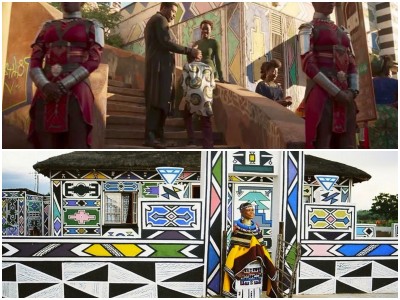The Cultural Influences of Marvel’s Black Panther
10. The Revolution Will Not be Televised — It’s Painted!

Top: T’Challa (Chadwick Boseman) and Nakia (Lupita Nyong’o) in the Wakandan marketplace. Photo Courtesy of Disney Bottom: Ndebele wall art in Mabhoko village. Photo Courtesy of Nick Pellegrino.
You may have also noticed some colorful wall art fom the marketplace that T’Challa and Nakia visits and some of Wakanda’s interiors (especially the main office of Shuri’s lab). It was said to have taken influences from Ndebele and Malian traditions of wall art. In history, the Ndebele people were oppressed by the Boers after being defeated in war with them in the late 19th century. It was through painting symbols with earthen tones where the people can communicate with each other. The Boers however didn’t not recognize these and found them harmless decorations for their houses. Little do they know that these were symbols of their adversity, a retelling of the Boers’ oppression, it was through art where they expressed their resistance towards them.
Over the years, the tradition lives on and there are different reasons as to why they paint them. For one, the bright colors indicate the occupant’s status or wealth; another would be the accomplishments of the household members; and with these being done by mostly women it is said that the household has a good wife or mother. They have yet to confirm what these symbols mean on the Wakandan context but Beachler did say that she hid symbols around for people to figure out and perhaps the lab could mean something.
Source:
SA History
























